Battersea Power StationŌĆÖs redevelopment has not had an easy time of it lately, with profit margins plummeting and costs soaring. The development company behind the scheme speaks exclusively to ║├╔½Ž╚╔·TV about the scale of the problems
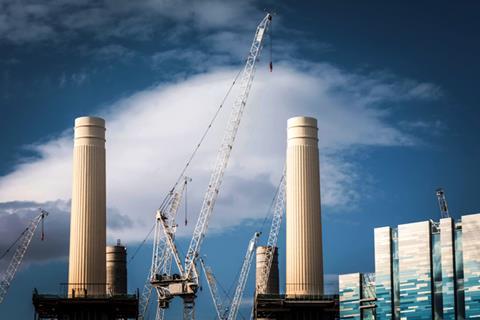
A political row over affordable housing on the gargantuan multibillion-pound Battersea Power Station redevelopment scheme has given the world a glimpse of the problems facing the project. Planning documents submitted to support the developer Battersea Power Station Development CompanyŌĆÖs attempt to reduce provision of affordable homes revealed the expected profit margin (known as IRR) on the 4,000-home project has more than halved from 20% to 8% since it started, as a result of a combination of a falling prime sales market and big cost rises.
For months, rumours of huge construction problems have swirled round the project, which is on site in three enormous phases totalling more than ┬Ż2bn of construction work. The head of WandsworthŌĆÖs planning committee described the scheme as being in ŌĆ£serious financial troubleŌĆØ, before later altering his online statement to say it was ŌĆō merely ŌĆō ŌĆ£facing significant challengesŌĆØ.
Now itŌĆÖs time for Rob Tincknell, chief executive of Battersea Power Station Development Company, speaking exclusively to ║├╔½Ž╚╔·TV, to put his side of the story ŌĆō and lay bare the scale of the projectŌĆÖs issues.
ŌĆ£This isnŌĆÖt called the Everest of real estate because itŌĆÖs easy. It is arguably the toughest project in the world, and the evidence is that itŌĆÖs sat here for 35 years. And IŌĆÖm sure that many developers who are still licking their wounds after being shot out the other end would agree.ŌĆØ
Here Tincknell lifts the lid on the scale of construction challenges facing the scheme, where costs have escalated by at least ┬Ż400│Š on the rebuilding of the power station alone. Speaking for the first time since the affordable housing provision row returned the job to the spotlight, he does not rule out that the cost of this vital Phase 2 part of the wider regeneration project, originally estimated at ┬Ż750m, could even end up doubling. However, he also tells ║├╔½Ž╚╔·TV why ŌĆō ŌĆ£despite its financial performanceŌĆØ ŌĆō the schemeŌĆÖs financial backers are utterly committed to finishing the job.
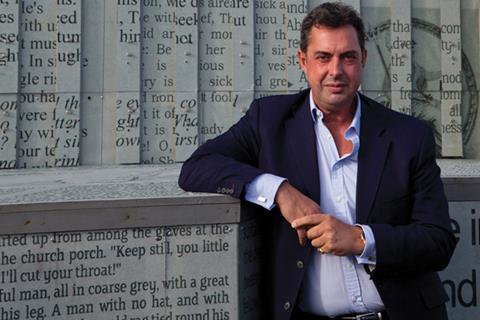
Out of the ordinary
Very little about the rebuilding of Battersea is ordinary, or, seemingly, even straightforward. From the decision to rebuild the iconic power station chimneys before the rest of the building; to the provision of an on-site hospital for site workers; to the aquifer running beneath the power station itself, which meant sinking piles 26m down to hit foundable rock; to the construction schedule for the ┬Ż400│Š, 865-home first phase of flats that required contractor Carillion to hand over 30 apartments every week.
Tincknell has made ŌĆ£donŌĆÖt do ordinaryŌĆØ into his teamŌĆÖs motto and remains clearly proud of what is being achieved - with residents moving into the first phase now, and the promised shops and community facilities springing to life. He thinks criticism of the development itself is misplaced. ŌĆ£ItŌĆÖs all about creating an amazing new place for London,ŌĆØ he says.
ŌĆ£When this site went on the market [in 2012], there were four to five bids and, apart from Chelsea Football Club, every single one of them was more or less ŌĆśknock down the power station and build rows and rows and rows of residentialŌĆÖ.
ŌĆ£Now that is not the answer to this site ŌĆō a new town centre for the whole of Nine Elms is the absolute right thing to do. [WeŌĆÖre] bringing jobs, bringing a new cultural capital for London, capitalising on the river, the heritage [ŌĆ”] having a mixed community. ItŌĆÖs not easy. Doing the right thing isnŌĆÖt necessarily the easiest thing.ŌĆØ
You can say that again. Because, back on the business side of the construction hoardings, all is far from rosy. Tincknell admits the construction cost overruns have been, simply, ŌĆ£vastŌĆØ. Most of the pain, he says, has come from the job to rebuild the power station itself, originally estimated at ┬Ż750m, the majority of which is being carried out by Skanska. Last year Tincknell admitted the contract price had risen to ┬Ż1.15bn, but it was indicated then that this was due to incorporating design changes and increases in SkanskaŌĆÖs scope of work.
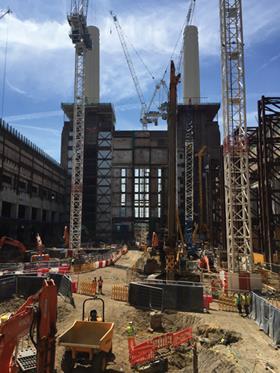
Big changes
So, what has happened? Tincknell says itŌĆÖs a combination of the hot market for construction, a much weaker pound making materials (60% of which come from Europe) more expensive, and ŌĆō most of all ŌĆō a gargantuan dollop of unforeseen site problems. The cost of rebuilding the chimneys, for example, was more complicated than anticipated, rising from ┬Ż28m to ┬Ż48m.
The cost of the underground energy centre between the power station and the river quadrupled from ┬Ż17m to ┬Ż62m. Most extraordinarily, after initial surveys based on limited access to the building put the cost of dealing with asbestos at just ┬Ż190,000, the reality was several orders of magnitude tougher, and asbestos costs soared 200-fold to ┬Ż44m. Tincknell said: ŌĆ£pretty much weŌĆÖve had to scrub the entire building with a toothbrushŌĆØ.
He says: ŌĆ£These things have been much more challenging than the entire team, everybody associated with the project, thought they would be. These are big, big changes.
ŌĆ£There are blocks of concrete in the ground the size of this room which have been challenging to remove. ThereŌĆÖs an aquifer under the power station that as weŌĆÖve excavated down we realised the piles needed to be longer, bigger [ŌĆ”] The upshot is weŌĆÖve literally spent ┬Ż400│Š [just] preparing the building for regeneration.
ŌĆ£The whole budget started off at ┬Ż750m, itŌĆÖs then been reported it went to ┬Ż1.15bn ŌĆō and itŌĆÖs now north of that figure. Those have been huge, huge, huge numbers.ŌĆØ
ThereŌĆÖs a reason why Tincknell canŌĆÖt give a final cost. This is that, three years after Skanska was chosen to rebuild the power station, no contract has ever been signed. Tendered as a two-stage, lump sum, design-and-build contract, the sheer volume of changes means the second stage has never been finalised and the contract remains officially ŌĆ£at largeŌĆØ in contract law terminology.
This is despite the fact work has clearly progressed some distance, with Tincknell saying ┬Ż400│Š of subcontracts have been placed and ŌĆ£several hundred million pounds moreŌĆØ have been tendered. However, other major packages, such as M&E, have not yet been tendered. To put this problem in perspective, Tincknell claims that even CarillionŌĆÖs ┬Ż400│Š Phase 1 contract was the largest ever let in the UK by a private developer. Phase 2 could be three times that size (see BatterseaŌĆÖs phases, below).
ŌĆ£WeŌĆÖre all working together very hard, tendering packages, day and night, doing a lot of value engineering to get costs in the right position that we can all sign up to and move forward together,ŌĆØ he says. ŌĆ£ThatŌĆÖs quite close, but [ŌĆ”] itŌĆÖs still being agreed.ŌĆØ Could it even end up being double the original ┬Ż750m estimate? ŌĆ£IŌĆÖm not going to say.ŌĆØ He pauses. ŌĆ£Hopefully not.ŌĆØ
About-turn
Tincknell admits this experience was behind the recent about-turn in approach on the 1,300-home Phase 3. This was originally tendered as a two-stage, lump sum contract, with French contractor Bouygues picked as preferred bidder, but Bouygues has now departed the job and Battersea has brought in Sir Robert McAlpine to build it on a construction management basis.
ŌĆ£Phase 3 was at an earlier stage [than Phase 2], and it made more logical sense to convert that back to a construction management process,ŌĆØ Tincknell says, admitting the risk premium Bouygues was looking to add onto the price was ŌĆ£one of the factorsŌĆØ in the decision. ŌĆ£Contractors, like most businesses, are just trying to avoid risk at the moment, because you donŌĆÖt know whatŌĆÖs going to happen around the corner.ŌĆØ Of Bouygues specifically, Tincknell simply says ŌĆ£we just mutually decided it just wasnŌĆÖt right for them and it wasnŌĆÖt right for us. ThereŌĆÖs no blood in the water. ItŌĆÖs just a better way forward for the project.ŌĆØ
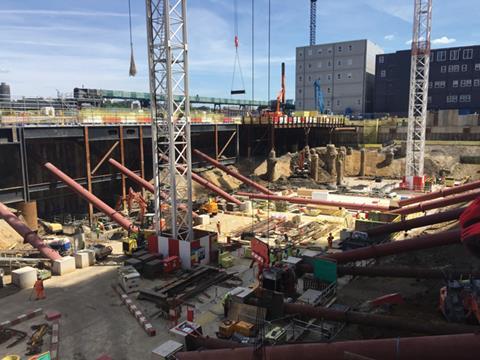
Other changes include the departure of Battersea Power Station Development CompanyŌĆÖs project director, Aidan McLeod, after just three years on the job. Since his departure Ian Feast, a project manager with experience at McAlpine, Hammerson and Cyril Sweett (as was), has been brought in, to be executive director of Phase 3. Again Tincknell insists there is no story to tell behind these changes, simply that ŌĆ£Aidan decided to leave of his own accordŌĆØ.
Some of the speculation surrounding the project is that BatterseaŌĆÖs decision to push ahead with all of the first three phases concurrently has worsened the cost escalation, with one senior figure at a contractor saying it had created a ŌĆ£micro-climateŌĆØ of enormous demand in one place. Tincknell admits keeping site workers has been very tough given buoyant conditions, citing the fact Carillion inducted on average 12 workers for every one of the 1,500 jobs on its phase because of the rate at which workers would be poached to work on other sites. But he rejects the idea of slowing things down. ŌĆ£If we did it one phase at a time weŌĆÖd be here for 40 years. YouŌĆÖve got to get on with it,ŌĆØ he says.
Good news
Balancing all this pain is the decision of Malaysian backers Sime Darby and SP Setia to remain completely committed to the project even though it has meant, Tincknell reveals, reaching into their pockets to inject additional equity. ŌĆ£The good news is that the shareholders are utterly committed to the regeneration of this building, despite its financial performance. This building [ŌĆ”] is going to become an unbelievable centrepiece for this wider development. But itŌĆÖs cost them.
ŌĆ£They are having to pay for this extra cost through large increases in the equity contribution they are making to the project. There arenŌĆÖt many international investors and developers who would have done that.ŌĆØ
Meanwhile the project remains at the centre of a political firestorm following its decision to reduce the guaranteed proportion of affordable housing from 15% to 9% across the development (see ŌĆ£Affordable housing rowŌĆØ, above). While Wandsworth council has approved the deal, last week LondonŌĆÖs Labour mayor Sadiq Khan accused the developer of ŌĆ£hoodwinkingŌĆØ the council, citing data from Wandsworth council stating Battersea is on course to make ┬Ż1.8bn in profit - a figure the council says dates from 2008.
Tincknell maintains the affordable housing offer is actually far more generous than it is required to be under the terms of the National Planning Policy Framework, and points out that the regeneration is also underpinning the construction of the Northern line extension to Battersea and the creation of commercial space for 20,000 permanent jobs.
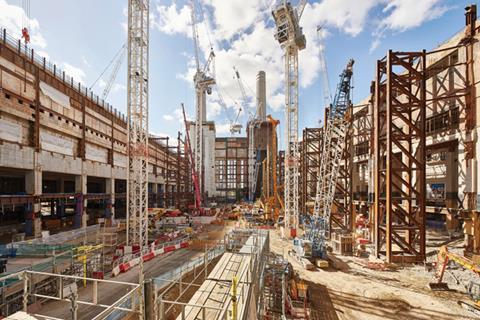
Hostile
But he says he is worried about what he sees as an increasingly hostile political climate for all developers in London. ŌĆ£We donŌĆÖt want to end up becoming a political football, because that just knocks [the scheme]. All these benefits that weŌĆÖre bringing on board, could become in jeopardy. WeŌĆÖre not another isolated, gated development.ŌĆØ
While the soaring construction costs have been the projectŌĆÖs biggest problem, Tincknell admits the fall in prime property sales has also had a ŌĆ£moderate, but impactfulŌĆØ effect on the plans.
So much so, he admits, thereŌĆÖs a chance that in Phase 4 to Phase 6 the development could be re-planned as a commercial rather than residential-led development. In addition, he says he has even scoped out the possibility of converting the second part of the Foster and Gehry Phase 3 to commercial. ŌĆ£The resi market is in a state of flux so weŌĆÖve looked at options regarding the buildings here [in the second part of Phase 3.] To make sure that we can make it happen weŌĆÖve looked at some different uses. That is just simply an exercise ŌĆō itŌĆÖs not some dramatic announcement,ŌĆØ he says, implying it is unlikely. ŌĆ£The reality is that actually weŌĆÖve done really well in sales of residential.ŌĆØ he says.
With the growing political controversy colliding with the construction woes, it is clear that whatever happens from now, the story of the regeneration of Battersea Power Station has got a long way to run yet.
BatterseaŌĆÖs phases
Construction has already begun on three of the Battersea projectŌĆÖs six phases.
Phase 1
Scheme: 865 homes, in two blocks designed by SimpsonHaugh and DRMM, sandwiched between the power station and overground line from Victoria
Cost: ┬Ż400│Š
Contractor: Carillion, fixed-price lump sum, with Skanska delivering the fit-out
- Carillion has completed construction of the first phase, which is currently being handed over to residents and commercial occupiers. While a change to the design of an energy centre led to a contract change after signing, Tincknell said rumours of problems and delays on this phase were incorrect and that Carillion had done a ŌĆ£brilliant jobŌĆØ, adding: ŌĆ£IŌĆÖm certain they will be taking a further role in later phases.ŌĆØ Tincknell said he didnŌĆÖt know if Carillion had made money on the contract, secured in the depths of the recession, and Carillion declined to answer whether the job has contributed to the ┬Ż375m of losses on UK problem jobs it revealed last week.
Phase 2
Scheme: Redevelopment of the power station itself, designed by Wilkinson Eyre, to provide 253 flats
and 500,000ft2 of office space with a new energy centre beneath
Cost: More than ┬Ż1.15bn
Contractor: Mace completed ┬Ż100m of works rebuilding the towers, with Skanska delivering the rest
- Originally estimated to cost ┬Ż750m, Tincknell has not ruled out that this phase could double in cost, given the extent of problems. Set to contain the UK HQ for Apple, it will include leisure and other public uses and form the centrepiece of the scheme. Procured as a two stage, design-and-build contract, Skanska is undertaking works without the contract having been finalised, meaning the price is still unknown.
Phase 3
Scheme: Construction of 1,305 apartments in six blocks south of the power station, one designed by Norman Foster with five smaller ones by Frank Gehry
Cost: Unknown (estimated ┬Ż1bn)
Construction manager: Sir Robert McAlpine
- Work is at an early stage, with the original intention for Bouygues to carry out a ┬Ż1bn design and build contract now scrapped, and McAlpine brought in as construction manager. Tincknell says Battersea is considering options to switch the later, southern portion of the scheme - which will be built over the new Battersea Northern line tube station ŌĆō to commercial uses, but no decision has been taken. He says 60 apartments have been sold in the last nine months.
Affordable housing row
Wandsworth council last month approved BatterseaŌĆÖs request to reduce the guaranteed amount of affordable housing on the scheme by 250 homes to 386, equivalent to just 9% of the total. The change also saw the introduction of a clawback mechanism by which, if the developmentŌĆÖs profitability - measured as Internal Rate of Return (IRR) - improves, the homes will be reinstated and even exceeded, up to a maximum of 33% of the total scheme.
However, viability consultant BNP Paribas Real Estate, working for the council, said that it was ŌĆ£very unlikelyŌĆØ anything other than the minimum level of affordable would be achieved, given that the IRR has fallen to 8.2%, well below the likely 15% threshold for reinstating.
London mayor Sadiq Khan said the change was ŌĆ£wholly unacceptableŌĆØ, had ŌĆ£let Londoners downŌĆØ and that he was seeking advice on how to stop it happening. WandsworthŌĆÖs planning committee chairman Richard Field said: ŌĆ£The escalating cost of restoring the power station building means this development project is facing significant challenges and the committee had a very difficult choice between accepting a potentially lower number of affordable homes, or refusing the application and risk[ing] losing all of them.ŌĆØ
Tincknell said: ŌĆ£Once the growth starts to come through, IŌĆÖm optimistic we can see a good return of profit and IRR and we can start to look at reintroducing more affordable housing at that point.ŌĆØ



























No comments yet